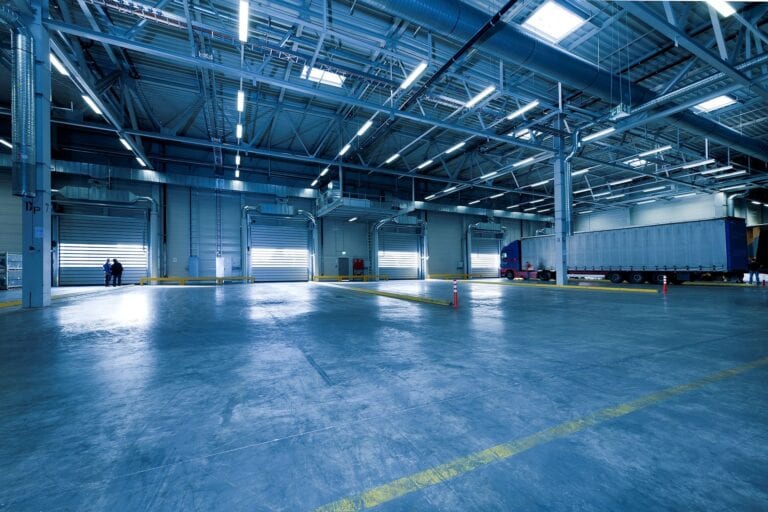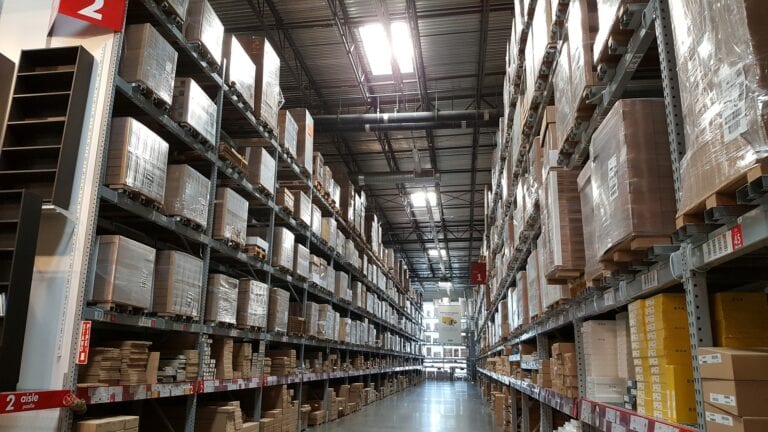Fulfilment centres are warehouses managed and equipped with third-party logistics for receiving, managing, and completing orders. A fulfilment centre is used to ship online orders to customers within the promised timeframe. Thereby, it helps free e-commerce companies from managing this cumbersome task regularly.
As a business owner, you can procure the shipment and verify the contents before sending them to the fulfilment centre. On the other hand, you can also send the load directly to the fulfilment centre. A fulfilment centre is a well-rounded solution for inventory management, last-mile deliveries, order tracking and many other aspects. They are a relatively modern concept and have emerged in the last two decades.
Fulfilment centres have rapidly increased in the last decade. They have helped many e-commerce merchants to operate their businesses from the convenience of their own home. No capital commitment or workforce is required to manage and supervise a fulfilment centre. That’s why they have become the go-to option for modern business owners.
How do fulfilment centres work?
A fulfilment centre has many processes that parallelly facilitate online orders’ movement to a customer’s doorstep. This entire procedure is also known as the order fulfilment process. An e-commerce retailer makes prior arrangements for inventory management. The inventory is stocked as planned in the designated fulfilment centre in anticipation of completing customer orders. As soon as a consumer completes his purchase on the online marketplace, the fulfilment procedure begins. The inventory is taken out to be packed in a box and then be labelled for shipment.
The best thing about fulfilment centres is that they can process both B2B orders and B2C orders. B2B orders usually entail a high volume of product that is sent directly to a big-box retailer. On the other hand, B2C orders are shipped directly to the consumer’s home who has ordered the product.
When a merchant outsources e-commerce order fulfilment, a third-party logistics provider executes the fulfilment process on the owner’s behalf. The method comprises everything from inventory management to rate negotiation with shipment carriers.
Hence, outsourcing order fulfilment processes to a third-party logistics provider is the best way to make it easier to manage inventory, improve customer service, and save the merchant a lot of time and effort to focus on expansion and other aspects of his business.
Benefits of using a fulfilment centre
There are a lot of benefits to using a fulfilment centre instead of setting up all operations in-house. The numerous benefits of fulfilment centres are why most e-commerce sellers opt for them rather than handling their own logistics operations. Even large companies have begun outsourcing their functions to fulfilment centres. They’ve done it because not only does it make financial sense, it also helps the company expand or shift its operations whenever it wants to.
Some of the key benefits of a fulfilment centre are :
1. Their experience is precious
The truth is that most business owners are not aiming to become a fulfilment expert with complete mastery of operations. They’re trying to run and grow their business in the best way possible.
By outsourcing one’s storage, packaging, and shipping to an accomplished and renowned fulfilment centre, a business has the opportunity to absorb the experience of their workers as well as their applications and their tools. Logistical experts know the operations of the fulfilment services exemplary and work round the clock to satisfy their clients and the product consumer. A business can revolutionise its industry and make it entirely streamlined by deploying fulfilment centres for its business.
2. Increased reach
There are currently more than a billion digital buyers all over the world. This number has only increased since the COVID-19 pandemic. As it has forced people to stay inside their homes, they do most of their shopping online. Hence, it is an excellent chance for companies to make the most out of their B2C model and upscale their sales globally.
A couple of decades ago, the cost of setting up a warehousing facility with fully functioning packaging and delivery options was the only way to expand. This idea was costly but very risky in case a product fails in a particular region. However, with the ease of availing a fulfilment centre, a business has the opportunity to expand as per their vision. In recent years, companies have used fulfilment services to experiment with different demographics while reserving heavy capital investments and gaining massive profits.
3. Increase space availability
Most startup e-commerce organisations operate through their basements, living rooms, and garages to maximise the space for supplies. Usually, these unorganised workplaces become untidy and tangled up in a mess of bubble wrap, tape, and other packaging supplies. However, one can circumvent the situation entirely with a fulfilment centre. They allow a user to outsource all these responsibilities to their third-party service provider so they can focus on more critical aspects of your business—like working on marketing, branding, customer satisfaction, product quality etc.
4. Improved customer service
Customer service is one of the essential parts of the online shopping experience. Buyers tend to flock to companies that can fulfil their orders quickly and safely regularly. If a customer is happy with the delivery services of a particular platform, they will tend to use that particular platform for more and more of their purchases. It is why the best companies all over the world value customer satisfaction.
A study found out that companies could be losing up to 62 billion dollars on an annual basis because of inadequate customer service. Moreover, the number of competing products in the market has increased substantially. Among many options, excellent customer service can be a great way to distinguish your business from the competitors in front of your consumers.
Most fulfilment centres have the availability of round the clock support via email or phone. Such customer service facilitates hassle-free returns, exchanges, and refunds. Additionally, as mentioned earlier, fulfilment centres can also fulfil same-day delivery choices and assured delivery dates. All of these factors contribute to improving the customer experience drastically.
5. More scalability
Most e-commerce product providers can fulfil their orders on their own for the longest time before growth. However, it is a known fact that once companies grow in size with more online traffic and increased product demand, it can get tediously challenging to fulfil orders in a quick and timely manner.
A company’s inability to match up with their demand can lead to an array of dissatisfied customers, negative testimonials online, and decreased interest in a company’s brand as a whole. However, a business owner can avoid such issues using fulfilment centres because they’re easy and quick to deploy. They’re the best way to increase one’s capacity and maintain a good reputation for order fulfilment. It is beneficial to deal with random/planned seasonal increased interest in your product.

How is a fulfilment centre different from a regular warehouse?
It is a common misconception that fulfilment centres are synonymous with typical warehouses. However, there are many distinctions between a standard warehousing option and a fulfilment centre. While they share the common element of storing inventory, a fulfilment centre provides extensive services, unlike its counterpart.
Moreover, they have an entirely different framework of operations and functioning. Let’s take a look at some of their fundamental differences.
1. Duration of storage
While there is a warehousing part to a third-party fulfilment centre, the primary aim of a fulfilment centre is to store and ship merchandise quickly. It requires the stock to be shipped as soon as possible after receiving it.
As a rule of thumb, inventory should not remain stagnant in a fulfilment centre for more than a month. If that’s the case, the merchant will have to continue paying high warehousing charges unnecessarily. It is necessary to strike a balance of inventory while availing fulfilment centres.
A business should aim to get the most ROI on its warehousing fees. Simultaneously, they should also ensure that there isn’t a shortage of their product during peak seasons. Hence, sellers should ship enough inventory to their fulfilment centres in advance in many cases. It will provide a sense of relief to the vendor that there is always enough inventory before shipment.
One can infer that the main objective of a warehousing solution is to store inventory for a long time. On the other hand, the job of a fulfilment centre is to match up to customer demands through shipping consistently. Companies should note that the practice is only financially feasible when retailers store inventory in fulfilment centres near their customers. Closer proximity to customers can reduce shipping charges, transit time, and shipping zones.
2. Frequency of pickups by shipping carriers
Unlike a generic warehouse, a fulfilment centre can maintain relationships with many different shipping carriers. Since a fulfilment centre functions to satisfy customer orders as soon as possible, they require shipping carriers to receive the shipment daily. The daily loads ensure that the orders will be delivered to consumers well within the guaranteed time. Fast delivery is crucial to high customer satisfaction.
However, some shipping carriers practice picking up customer orders multiple times a day for promised one-day or same-day delivery options as chosen by the user. Of course, it depends on the nature of the services offered by the fulfilment centre. The regular shipments and services will have routinely catalogued pickups. It includes international shipments and domestic shipments too.
Most retail e-commerce merchants have cutoff times to be eligible for express delivery options. On the other hand, a warehouse usually requires scheduled, less regular pickups. It is done because it is more financially feasible to ship the product and hold boxes packed together in a shipment rather than separate shipping labels.
Shipping companies tend to consolidate inventory from different pickup spots for PTL and LTL freight shipments. Since these shipments can cause a setback in pickup timing, the merchants try to opt for a more extended turnaround time.
Fulfilment centres in the age of e-commerce
Outsourcing logistics and distribution with fulfilment centres have brought about a massive shift in the industrial perspective towards e-commerce. Fulfilment centres have been the cause of growth in the logistics and distribution industry. But more importantly, they have eased the process of becoming an entrepreneur and running an individual business.
This is the primary reason why major online stores have begun to see the potential value of fulfilment centre. Every major online retail store currently has a sturdy fulfilment centre service to offer its merchants. It is important to note that the trend has only grown in the B2C business places, but also in B2B companies. Since B2B companies usually deal with large shipments and large deliveries, their need for more space at a moment’s notice has made the industry heavily reliant on fulfilment centres.
Based on the recent trend, more and more online retailers will begin to use fulfilment centres to cater to their customers. With the scalability of fulfilment centres, expanding and marketing one’s product to different countries worldwide has also gotten much more accessible. The age of fulfilment centres has led to reduced costs for the merchant, faster deliveries and happier customers worldwide.
Future integration of fulfilment centres with data analytics and IoT
IoT is a rapidly growing field with applications in every industry. IoT offers a range of features, and any warehouse can implement them to help the everyday worker in his routine tasks and increase productivity and work satisfaction rapidly. Companies are beginning to use data analytics and IoT in many aspects of their business. Similarly, fulfilment centres can be of more use to business owners with such integrations.
1. IoT
With IoT, a standard warehouse manager can keep track of every moving part from the comfort of his desk with simple steps and one-time installations. Sensors can keep an inventory account and accordingly alert the manager whenever it goes below a specific limit. Moreover, managers can track every worker’s movements and whereabouts with particular tags. Such tags can help improve performance and act immediately in case of any work-related accidents in a large warehouse.
GPS and related devices help a package take the set route, ensure that the trip is completed in due time, and help the manager know about any changes or mishaps during the journey. Most importantly, IoT trackers and sensors can be deployed and used as a measure against theft in most warehouses. They can trip the alarm and inform you of any theft during a centre’s downtime. Additionally, they can also contact the concerned authorities and ensure that no inventory is stolen.
2. Data analytics
Data analytics can help a business owner take smarter decisions about his/her business operations. Over a long time of operating, companies can data analytics can manipulate the data received to show essential metrics and figures about their business. They can help know the most significant cause behind errors and losses, making them visible for the concerned department to fix right away.
Additionally, it can help you maintain inventory well in advance, predict seasonal peaks, store inventory information, location, etc. These processes can automate multiple aspects of your supply chain, leading to increased efficiency and lesser room for mistakes.

Find the right Fulfilment Centre
Order fulfilment is a critical component of your overall business operations. If you are experiencing signs that reveal your current eCommerce company’s failure to deliver, it’s time for you to get smart about your next steps in fulfilling orders with the best providers out there. However, any changes should not be taken lightly. Follow these basic guidelines if you want to ensure success:
- Spend enough time on research – It might take more than just one day of research before making an informed decision on what type of provider will work well for both customer needs as well as yours. So, don’t rush through this process too quickly or hastily, take ample time researching who would provide.
- Define your goals from the very start – One of the biggest mistakes made by newer companies is that they have ambiguity in terms of what they need. While researching, it is important to analyse your needs and scale your expectations from the very beginning.
- Evaluate the provider’s niche by reviewing his past experience – Past work experience of a company is highly valuable in determining the kind of expertise and experience they bring to the table. After all, you want a set of experienced professionals to manage your product and its logistics operations. You can ensure that you’re hiring the people from the job based on what they’ve done before and how it was received by their clients in the past.
Related posts
- Guide To 3PL In Reverse Logistics
- 3 ways to design your distribution network
- What Is A Shipping Label?
- Navigate Supply Chain Disruptions With Digitalization
- How Can Technology Improve Last-Mile Delivery?
- 7 Major Challenges Of Last-mile Delivery
- First-Mile Delivery vs Last-Mile Delivery
- What Is First Mile Delivery?
- 10 Proven Methods To Reduce Delivery Time
- 7 Latest Freight Forwarding Trends In 2024
- 10 Best Third-Party Logistics (3PL) Companies In Chennai
- Top 11 E-commerce Fulfillment Companies In India
- 10 Best Third Party Logistics (3PL) Companies In Bangalore [2024]
